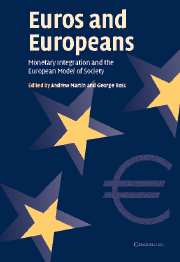Book contents
- Frontmatter
- Contents
- Preface
- List of contributors
- 1 Introduction: EMU and the European social model
- 2 The EMU macroeconomic policy regime and the European social model
- 3 Shaping a polity in an economic and monetary union: the EU in comparative perspective
- 4 Monetary integration and the French model
- 5 EMU and German welfare capitalism
- 6 Maastricht to modernization: EMU and the Italian social state
- 7 Constraint or motor? Monetary integration and the construction of a social model in Spain
- 8 The Netherlands: monetary integration and the Polder model
- 9 Belgium: monetary integration and precarious federalism
- 10 The political dynamics of external empowerment: the emergence of EMU and the challenge to the European social model
- 11 Welfare reform in the shadow of EMU
- 12 Industrial relations in EMU: are renationalization and Europeanization two sides of the same coin?
- 13 Conclusions
- References
- Index of names
- Index of subjects
9 - Belgium: monetary integration and precarious federalism
Published online by Cambridge University Press: 22 September 2009
- Frontmatter
- Contents
- Preface
- List of contributors
- 1 Introduction: EMU and the European social model
- 2 The EMU macroeconomic policy regime and the European social model
- 3 Shaping a polity in an economic and monetary union: the EU in comparative perspective
- 4 Monetary integration and the French model
- 5 EMU and German welfare capitalism
- 6 Maastricht to modernization: EMU and the Italian social state
- 7 Constraint or motor? Monetary integration and the construction of a social model in Spain
- 8 The Netherlands: monetary integration and the Polder model
- 9 Belgium: monetary integration and precarious federalism
- 10 The political dynamics of external empowerment: the emergence of EMU and the challenge to the European social model
- 11 Welfare reform in the shadow of EMU
- 12 Industrial relations in EMU: are renationalization and Europeanization two sides of the same coin?
- 13 Conclusions
- References
- Index of names
- Index of subjects
Summary
Monetary integrationhas long played a central but complicated part in Belgian politics. Exchange rates and their stability are important: the country depends on transformation of intermediate goods, and its industry exports approximately two-fifths of its output to neighboring countries (France, Germany, and the Netherlands). Belgium thus had a high stake in the first wave of EMU – to have failed would have meant pressures on its currency, inflationary tendencies, high interest rates, and increased unemployment – all with political costs. As a founding member of the European Community (EC), Belgium has been one of the strongest supporters of political integration, with an electorate which is one of the most pro-EU among the member states. Failure to qualify for EMU at its inception would have therefore discredited Belgium's claim to more European (federal) integration. Failure might also have undermined a source of national cohesion, as Europe, and the constraints imposed by monetary integration, have counterbalanced long-standing regional divisions. European monetary integration and its effect on the Belgian labor regime are thus tightly connected with Belgian political integration and national identity.
Belgium is divided into three regions: Dutch-speaking and largely Catholic Flanders, Francophone and largely secular Wallonia, and the bilingual capital region, Brussels. Cultural differences have coincided with changing economic conditions. Wallonia was the more prosperous region in the early postwar period but its old industries have suffered continuing decline.
- Type
- Chapter
- Information
- Euros and EuropeansMonetary Integration and the European Model of Society, pp. 201 - 225Publisher: Cambridge University PressPrint publication year: 2004
- 3
- Cited by



